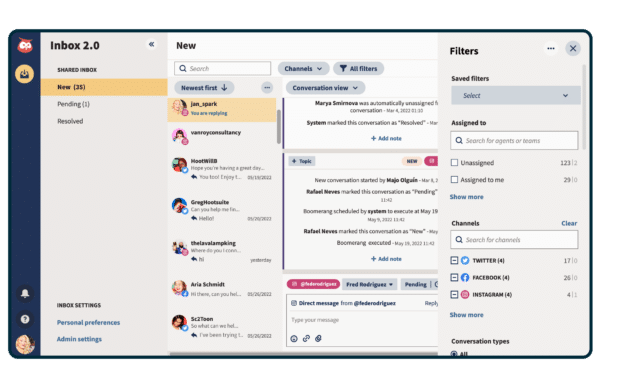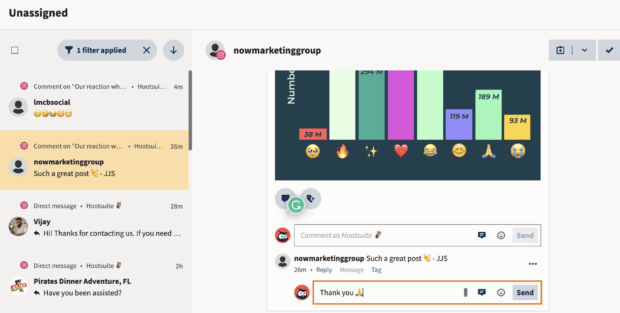8 Ways a Social Inbox Will Make Your Job Easier
A social media inbox is an important tool for all social media managers. Without one, social interactions are disjointed across platforms. They lack the context of your ongoing relationship with every customer and prospect.
Conversely, a unified social inbox allows seamless collaboration among social teams. Customer history and attributes are always at your fingertips. Life becomes easier for both your customers and your team.
Find out more about how using a central social inbox can help your team save time and work smarter, not harder.
Bonus: Get a free, easy-to-use Customer Service Report Template that helps you track and calculate your monthly customer service efforts all in one place.
What is a social inbox?
A social inbox is a tool that allows you to manage public and private messages from all popular social media platforms in one place. It includes customer service and engagement features that make it easy for a social team to work together.
Using a social inbox is the best way to respond to followers, customers, and prospects accurately and in good time. It can help marketing and customer service teams, small business owners, and solo social media managers save time and stay on top of incoming messages from multiple social media accounts.
A good social media inbox includes automation, tracking, and reporting features. It’s a true customer service platform, rather than simply a social media message management system.

Manage all your messages stress-free with easy routing, saved replies, and friendly chatbots. Try Hootsuite’s Inbox today.
Book a Demo8 benefits of using a unified social inbox
A unified social media inbox helps you manage social media with less stress and improves your brand reputation by makig it easier for customers to interact with your brand online — but that’s not all it can do for your team.
1. Save time and simplify handling messages
Social media inbox management tools integrate automation and smart routing features. They assign messages to the right member of your team without any supervisor intervention. Language detection is an especially important component if you operate across multiple regions.
Your social media inbox should also include a search function. This allows you to search all public and private comments on your inbound channels so you can find similar questions from the past, review older conversations, and spot trends. Search is especially helpful for content moderators.
What to look for when choosing a social media inbox:
- Ability to review message queues
- Ability to assign and tag incoming messages both manually and automatically
- Message status reviews and filtering
- Interaction search and filtering
2. Keep response times low
Response time is a key metric for social customer care teams. And for good reason. 79% of consumers expect a social media response within 24 hours, and 40% expect a response within just one hour.
Assuming you’ve set reasonable targets, your team is likely doing a great job of meeting expectations during business hours – when things are running smoothly.
But social messages and comments don’t always come in at a predictable pace, or at predictable times. When message volume spikes without warning, an all-in-one social inbox helps triage and organize messages to keep response times low and ensure no action items fall through the cracks.
Managing all your messages from one dashboard also significantly reduces the time lost to checking multiple DM inboxes across social networks.
What to look for when choosing a social media inbox:
- Single log-on for all social messaging
- Business hours indicators and after-hours auto-responses
- Message automations and autoresponders
- Intelligent chatbot and virtual agent capabilities
- Response time reporting and analysis
- Message volume reporting
- Supervisor dashboard
3. Work better as a team
A social inbox provides a full record of who said what to whom and when, regardless of which channel the conversation started on and if it switched from public to private or vice versa.
This gives your team the full context of any conversation, so you can avoid duplicate conversations on multiple platforms while providing the most detailed response possible.
What to look for when choosing a social inbox:
- View and respond to posts on all your social profiles
- Suggested replies and tags
- Record of both dark and organic comments
- Separate agent and supervisor views
- Automated prevention of duplicate responses by multiple team members
- Ability for customer care supervisors to view conversations, topics, and CSAT in real time
4. Never miss an important interaction
Since a social media inbox allows you to manage public and private interactions in one place, you will never miss an interaction. You can also set up keyword monitoring so you can see when people mention your brand even when you are not tagged
Even better, when you integrate your social inbox with your CRM, you have all the data about every customer you interact with at your fingertips every time you communicate. Data flows from your CRM to the social inbox and vice versa, so every record is up-to-date and you understand where every contact is in the purchasing process.
What to look for when choosing a social media inbox:
- Access and ability to respond to private, direct, and public messages as well as mentions and reactions across platforms
- Keyword search streams and monitoring
- Integrations with tools like Salesforce and Microsoft Dynamics
5. Manage crises with ease
When crises hit, it’s important to have an accurate picture of what’s happening across all your social messaging channels. A social inbox makes it easy to understand the full picture of what’s happening so you can report up the stakeholder chain and make sure executives have the information they need to make decisions quickly.
Once you determine the appropriate response, a social inbox helps make sure everyone who’s engaged with your brand gets a timely and appropriate response that’s aligned with the brand messaging to address the crisis.
What to look for when choosing a social media inbox:
- Ability to triage incoming messages for priority response
- Ability to monitor comments and engagement across platforms
- Ability to create auto-replies on the fly
- SLA alerts
6. Measure customer satisfaction
A social inbox with pre-installed customer satisfaction surveys and analytics gives you immense insight into how your customers feel about your brand and your team. Rather than analyzing sentiment and satisfaction on each individual platform, you get a picture of customer satisfaction with your cross-platform social response.
What to look for when choosing a social media inbox:
- Full CSAT reports and analysis
- Ability to monitor CSAT in real time
- Ability to filter CSAT reports for maximum reporting insight
7. Collect customer intelligence
When used as a social listening tool, a social inbox helps you better understand who is engaging with your brand on social media.
Are you getting comments and mentions from existing customers? Prospects? How do the questions people ask about your products and services differ pre- and post-purchase?
The information you gain can help you develop audience personas, better define your target market, and create more effective FAQs and product documentation.
What to look for when choosing a social media inbox:
- Two-way communication and data flow with your CRM
- Search and filter functions
- Ability to add notes and attributes to customer files and social conversations
8. Provide better customer service
A social inbox allows your team to provide the best customer care, engagement, and outreach. Automated message routing cuts down on the time required to get each message into the hands of the most qualified team member.
Meanwhile, intelligent chatbots resolve a good portion of customer messages without your team even getting involved. In Hootsuite’s 2023 Social Trends Survey, only 26% of organizations that use social as a primary customer service channel said they were using chatbots. Making the most of AI now is a great way to get ahead of the pack.
What to look for when choosing a social media inbox:
- Message routing to the right team member
- Customer satisfaction surveys
- Chatbot conversations (using AI for the best result)
How to use the Hootsuite Inbox
The Hootsuite Inbox helps bridge the gap between social media and customer service. Here’s how to start your day with Hootsuite Inbox to clear your message queue before lunch.
Find video easier to follow? We got you:
1. Open the agent workspace to the conversation view
This shows you the entire history of an individual’s interactions with your brand. You’ll also see contact information pulled from your CRM, which you can edit or add to as you interact with the customer. Anything you add flows back into the CRM, so your sales team is always up to date. Be sure to check the notes to see if there’s any additional information that will help you personalize your social replies.
2. Search previous conversations
Use the search function to search all messages by keyword or customer. This is a great way to save time and improve consistency when dealing with similar conversations. A quick search can also help you get a sense of how customers and prospects are feeling about any given topic.
3. Review your message queue
Your message queue provides a list of every conversation, including which social media channel it came from, when it was sent, and who it’s currently assigned to. You can see all messages sorted by status: new pending, or resolved, and search or filter conversation to make sure you focus on the most relevant.
4. Manage assignments
Hootsuite Inbox uses smart routing features and language detection to assign messages automatically to the right team member. If you prefer to assign a message automatically, or you want to change an assignment, you can do so with just a couple of clicks. Reroute messages to billing, sales, or any other relevant department to get your customer the fastest and most accurate response.
5. Set up automations
Within Hootsuite Inbox, set up automated CSAT surveys and SLA notifications. This is also where you can set up auto-responses and program your AI-powered chatbot.
6. Send your responses
When it’s time to reply to a comment or message, you can type from scratch, or you can choose to edit a saved reply to cut down on your response time. Hit Enter to send the response, then click Resolved to show the message has been dealt with.
Check the queue one more time to see if any new messages require your attention. Otherwise, you’re done!
Save time building an efficient customer support system on social media with Hootsuite. Respond to questions and complaints, create tickets from social conversations, and work with chatbots all from one dashboard. See it in action.
Save time on social messaging with automated responses, smarter workflows, and friendly chatbots — all in the Hootsuite Inbox.
Free DemoThe post 8 Ways a Social Inbox Will Make Your Job Easier appeared first on Social Media Marketing & Management Dashboard.
Categories
- 60% of the time… (1)
- A/B Testing (2)
- Ad placements (3)
- adops (4)
- adops vs sales (5)
- AdParlor 101 (43)
- adx (1)
- algorithm (1)
- Analysis (10)
- Apple (1)
- Audience (1)
- Augmented Reality (1)
- authenticity (1)
- Automation (1)
- Back to School (1)
- best practices (2)
- brand voice (1)
- branding (1)
- Build a Blog Community (12)
- Case Study (3)
- celebrate women (1)
- certification (1)
- Collections (1)
- Community (1)
- Conference News (1)
- conferences (1)
- content (1)
- content curation (1)
- content marketing (1)
- contests (1)
- Conversion Lift Test (1)
- Conversion testing (1)
- cost control (2)
- Creative (6)
- crisis (1)
- Curation (1)
- Custom Audience Targeting (4)
- Digital Advertising (2)
- Digital Marketing (6)
- DPA (1)
- Dynamic Ad Creative (1)
- dynamic product ads (1)
- E-Commerce (1)
- eCommerce (2)
- Ecosystem (1)
- email marketing (3)
- employee advocacy program (1)
- employee advocates (1)
- engineers (1)
- event marketing (1)
- event marketing strategy (1)
- events (1)
- Experiments (29)
- F8 (2)
- Facebook (64)
- Facebook Ad Split Testing (1)
- facebook ads (18)
- Facebook Ads How To (1)
- Facebook Advertising (30)
- Facebook Audience Network (1)
- Facebook Creative Platform Partners (1)
- facebook marketing (1)
- Facebook Marketing Partners (2)
- Facebook Optimizations (1)
- Facebook Posts (1)
- facebook stories (1)
- Facebook Updates (2)
- Facebook Video Ads (1)
- Facebook Watch (1)
- fbf (11)
- first impression takeover (5)
- fito (5)
- Fluent (1)
- Get Started With Wix Blog (1)
- Google (9)
- Google Ad Products (5)
- Google Analytics (1)
- Guest Post (1)
- Guides (32)
- Halloween (1)
- holiday marketing (1)
- Holiday Season Advertising (7)
- Holiday Shopping Season (4)
- Holiday Video Ads (1)
- holidays (4)
- Hootsuite How-To (3)
- Hootsuite Life (1)
- how to (6)
- How to get Instagram followers (1)
- How to get more Instagram followers (1)
- i don't understand a single thing he is or has been saying (1)
- if you need any proof that we're all just making it up (2)
- Incrementality (1)
- influencer marketing (1)
- Infographic (1)
- Instagram (39)
- Instagram Ads (11)
- Instagram advertising (8)
- Instagram best practices (1)
- Instagram followers (1)
- Instagram Partner (1)
- Instagram Stories (2)
- Instagram tips (1)
- Instagram Video Ads (2)
- invite (1)
- Landing Page (1)
- link shorteners (1)
- LinkedIn (22)
- LinkedIn Ads (2)
- LinkedIn Advertising (2)
- LinkedIn Stats (1)
- LinkedIn Targeting (5)
- Linkedin Usage (1)
- List (1)
- listening (2)
- Lists (3)
- Livestreaming (1)
- look no further than the new yorker store (2)
- lunch (1)
- Mac (1)
- macOS (1)
- Marketing to Millennials (2)
- mental health (1)
- metaverse (2)
- Mobile App Marketing (3)
- Monetizing Pinterest (2)
- Monetizing Social Media (2)
- Monthly Updates (10)
- Mothers Day (1)
- movies for social media managers (1)
- new releases (11)
- News (79)
- News & Events (12)
- no one knows what they're doing (2)
- OnlineShopping (2)
- or ari paparo (1)
- owly shortener (1)
- Paid Media (2)
- People-Based Marketing (3)
- performance marketing (5)
- Pinterest (34)
- Pinterest Ads (11)
- Pinterest Advertising (8)
- Pinterest how to (1)
- Pinterest Tag helper (5)
- Pinterest Targeting (6)
- platform health (1)
- Platform Updates (8)
- Press Release (2)
- product catalog (1)
- Productivity (10)
- Programmatic (3)
- quick work (1)
- Reddit (3)
- reels (1)
- Reporting (1)
- Resources (30)
- ROI (1)
- rules (1)
- Seamless shopping (1)
- share of voice (1)
- Shoppable ads (4)
- short-form video (1)
- shorts (1)
- Skills (26)
- SMB (1)
- SnapChat (28)
- SnapChat Ads (8)
- SnapChat Advertising (5)
- Social (153)
- social ads (1)
- Social Advertising (14)
- social customer service (1)
- Social Fresh Tips (2)
- Social Media (5)
- social media automation (1)
- social media content calendar (1)
- social media for events (1)
- social media management (2)
- Social Media Marketing (49)
- social media monitoring (1)
- Social Media News (4)
- social media statistics (1)
- social media tracking in google analytics (1)
- social media tutorial (2)
- Social Toolkit Podcast (1)
- Social Video (5)
- stories (1)
- Strategy (742)
- terms (1)
- Testing (2)
- there are times ive found myself talking to ari and even though none of the words he is using are new to me (1)
- they've done studies (1)
- this is also true of anytime i have to talk to developers (1)
- tiktok (9)
- tools (1)
- Topics & Trends (3)
- Trend (12)
- Twitter (15)
- Twitter Ads (5)
- Twitter Advertising (4)
- Uncategorised (9)
- Uncategorized (13)
- url shortener (1)
- url shorteners (1)
- vendor (2)
- video (11)
- Video Ads (7)
- Video Advertising (8)
- virtual conference (1)
- we're all just throwing mountains of shit at the wall and hoping the parts that stick don't smell too bad (2)
- web3 (2)
- where you can buy a baby onesie of a dog asking god for his testicles on it (2)
- yes i understand VAST and VPAID (1)
- yes that's the extent of the things i understand (1)
- YouTube (13)
- YouTube Ads (4)
- YouTube Advertising (9)
- YouTube Video Advertising (5)


